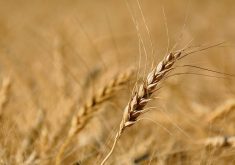Below is information from my farm at Dundurn, Sask., about 35 km south of Saskatoon, including the results of recent soil moisture probing.
Soil: Dark brown loam, which holds 1.5 inches of available water per foot of moist (field capacity) soil. Completely recharged at seeding on May 13, 2013.
Rain: May, 1.7 inches; June, 4.6 inches; July 6, 1.6 inches; July 21-24, one inch in small bits. No rain after July 24, but with that rain distribution, the crop did not dry the soil to a great depth.
Read Also

USDA cuts US corn stocks outlook after raising exports to record high
The U.S. Department of Agriculture lowered its U.S. corn supply forecast in a monthly supply-and-demand report on Friday and raised its outlook for U.S. exports of the grain this season to a record high following a strong pace of overseas shipments.
The crop was combined Aug. 25, with peas yielding 55 bushels per acre. The surface soil was so dry it could not be probed.
Aug. 31 saw half an inch of rain but conditions were so hot and dry it was gone in a few days. A fall anhydrous application is likely not possible.
The farm on Sept. 25-26 received 2.25 inches of nice slow rain with no gully washers; it all soaked in.
On Sept. 29, following the recent rains, the wetting front — the line between the layer of wet soil below the surface and the drier soil beneath that layer — was measured at 18 inches down, exactly as the theory predicted.
Soil moisture profile, Sept. 29
| Surface to 18 inches | Field capacity. |
| 18 to about 28 inches | Drier soil, but not completely sucked dry. |
| Below 28 inches | Field capacity. |
The bottom line
There are only approximately 10 inches of soil to be wet up and the profile is completely recharged. Any amount of further rain or snow melt will do the job. There is a very good chance that the soil will be fully recharged for the 2014 crop. I plan to put on 80 to 100 pounds of nitrogen per acre, as soon as I can line up anhydrous.
So, if your agronomist is moisture-probing the soil in your fields this fall, make sure he or she checks for residual soil moisture below the dry layer.
— Les Henry, a contributing columnist for Grainews and a retired soil science professor, farms and writes in the Saskatoon area.















